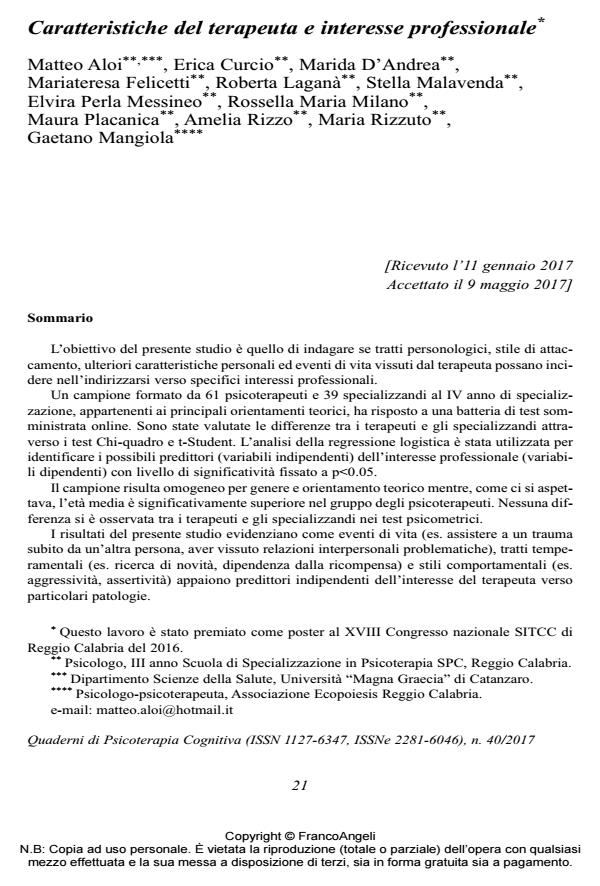Caratteristiche del terapeuta e interesse professionale
Titolo Rivista QUADERNI DI PSICOTERAPIA COGNITIVA
Autori/Curatori Matteo Aloi, Erica Curcio, Marida D’Andrea, Mariateresa Felicetti, Roberta Laganà, Stella Malavenda, Elvira Perla Messineo, Rossella Maria Milano, Maura Placanica, Amelia Rizzo, Maria Rizzuto, Gaetano Mangiola
Anno di pubblicazione 2017 Fascicolo 2017/40
Lingua Italiano Numero pagine 17 P. 21-37 Dimensione file 144 KB
DOI 10.3280/QPC2017-040002
Il DOI è il codice a barre della proprietà intellettuale: per saperne di più
clicca qui
Qui sotto puoi vedere in anteprima la prima pagina di questo articolo.
Se questo articolo ti interessa, lo puoi acquistare (e scaricare in formato pdf) seguendo le facili indicazioni per acquistare il download credit. Acquista Download Credits per scaricare questo Articolo in formato PDF

FrancoAngeli è membro della Publishers International Linking Association, Inc (PILA)associazione indipendente e non profit per facilitare (attraverso i servizi tecnologici implementati da CrossRef.org) l’accesso degli studiosi ai contenuti digitali nelle pubblicazioni professionali e scientifiche
L’obiettivo del presente studio è quello di indagare se tratti personologici, stile di attaccamento, ulteriori caratteristiche personali ed eventi di vita vissuti dal terapeuta possano incidere nell’indirizzarsi verso specifici interessi professionali. Un campione formato da 61 psicoterapeuti e 39 specializzandi al IV anno di specializzazione, appartenenti ai principali orientamenti teorici, ha risposto a una batteria di test somministrata online. Sono state valutate le differenze tra i terapeuti e gli specializzandi attraverso i test Chi-quadro e t-Student. L’analisi della regressione logistica è stata utilizzata per identificare i possibili predittori (variabili indipendenti) dell’interesse professionale (variabili dipendenti) con livello di significatività fissato a p<0.05. Il campione risulta omogeneo per genere e orientamento teorico mentre, come ci si aspettava, l’età media è significativamente superiore nel gruppo degli psicoterapeuti. Nessuna differenza si è osservata tra i terapeuti e gli specializzandi nei test psicometrici. I risultati del presente studio evidenziano come eventi di vita (es. assistere a un trauma subito da un’altra persona, aver vissuto relazioni interpersonali problematiche), tratti temperamentali (es. ricerca di novità, dipendenza dalla ricompensa) e stili comportamentali (es. aggressività, assertività) appaiono predittori indipendenti dell’interesse del terapeuta verso particolari patologie.
Parole chiave:Caratteristiche del terapeuta, esperienze del terapeuta, personalità, orientamento teorico
Matteo Aloi, Erica Curcio, Marida D’Andrea, Mariateresa Felicetti, Roberta Laganà, Stella Malavenda, Elvira Perla Messineo, Rossella Maria Milano, Maura Placanica, Amelia Rizzo, Maria Rizzuto, Gaetano Mangiola, Caratteristiche del terapeuta e interesse professionale in "QUADERNI DI PSICOTERAPIA COGNITIVA" 40/2017, pp 21-37, DOI: 10.3280/QPC2017-040002